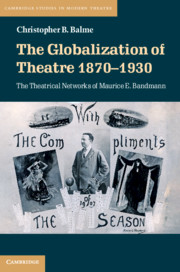Book contents
- The Globalization of Theatre 1870–1930
- Cambridge Studies in Modern Theatre
- The Globalization of Theatre 1870–1930
- Copyright page
- Contents
- Figures
- Tables
- Acknowledgements
- Notes on Currency
- Introduction
- 1 Family Networks
- 2 Mobile Enterprises
- 3 The Micropolitics of Locality
- 4 Repertoire and Publics
- 5 Transported Actors
- 6 Contested Contracts
- 7 Infrastructure: From Theatre to Cinema
- 8 Legacies
- Bibliography
- Index
Introduction
Published online by Cambridge University Press: 12 October 2019
- The Globalization of Theatre 1870–1930
- Cambridge Studies in Modern Theatre
- The Globalization of Theatre 1870–1930
- Copyright page
- Contents
- Figures
- Tables
- Acknowledgements
- Notes on Currency
- Introduction
- 1 Family Networks
- 2 Mobile Enterprises
- 3 The Micropolitics of Locality
- 4 Repertoire and Publics
- 5 Transported Actors
- 6 Contested Contracts
- 7 Infrastructure: From Theatre to Cinema
- 8 Legacies
- Bibliography
- Index
Summary
The Introduction outlines the geographical scope of Maurice E. Bandmann’s theatrical circuit and the theoretical and methodological approach of the book. The first section provides a detailed discussion of two approaches to network theory: historical network analysis and actor-network theory (ANT), which is associated with Bruno Latour. A second section discusses the term ‘first age of globalization’, meaning here the period of 1870 to 1914 and how it is relevant to theatre history, in particular the study of itinerant theatre.
Keywords
- Type
- Chapter
- Information
- The Globalization of Theatre 1870–1930The Theatrical Networks of Maurice E. Bandmann, pp. 1 - 23Publisher: Cambridge University PressPrint publication year: 2019

